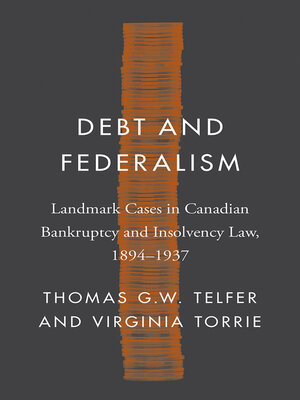Debt and Federalism
ebook ∣ Landmark Cases in Canadian Bankruptcy and Insolvency Law, 1894-1937 · Landmark Cases in Canadian Law
By Thomas Telfer

Sign up to save your library
With an OverDrive account, you can save your favorite libraries for at-a-glance information about availability. Find out more about OverDrive accounts.
Find this title in Libby, the library reading app by OverDrive.



Search for a digital library with this title
Title found at these libraries:
| Library Name | Distance |
|---|---|
| Loading... |
The legal meaning of bankruptcy and insolvency law has often remained elusive, even to practitioners and scholars in the field, despite having been enshrined in Canada's Constitution since Confederation. Federal jurisdiction in this area must be measured against provincial powers over property, civil rights, and other aspects of provincial power.
Debt and Federalism traces changing conceptions of the federal bankruptcy and insolvency power through four landmark cases that together form the constitutional foundation of the Canadian bankruptcy system: the 1894 Voluntary Assignments Case, Royal Bank of Canada v Larue in 1928, the 1934 Companies' Creditors Arrangement Act Reference Case, and the 1937 Farmers' Creditors Arrangement Act Reference Case. At times when federal and provincial views appeared seemingly irreconcilable, each decision incrementally laid the groundwork for the next constitutional challenge, ultimately producing the bedrock for modern understandings of bankruptcy and insolvency law.
Thomas G.W. Telfer and Virginia Torrie draw on a wide array of archival and legal sources to analyze the four decisions from a historical and doctrinal perspective, and to situate them within the appropriate social, economic, and political contexts. This astute book demonstrates that together, the specific legal changes brought about by these landmark cases underpin contemporary bankruptcy and insolvency law and scholarship.







